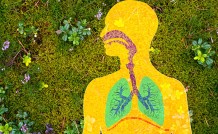Online Class: Understanding Allergies 101

no certificate
with CEU Certificate*
-
9Lessons
-
11Exams &
Assignments -
341Students
have taken this course -
3Hours
average time -
0.3CEUs
Course Description
Allergy Insights: Delving Deep into the Human Allergic Response
Allergies remain one of life's most perplexing phenomena. Why does a fragrant flower stir sneezes in one individual and admiration in another? What underpins these differences? Our comprehensive course, "Allergy Insights," seeks to unravel these mysteries, offering you a deep dive into the captivating world of allergies.
Journey Highlights:
-
Foundation of Allergic Responses: Begin with the basics. Understand the intricate ballet that the body performs when presented with allergens. Explore the scientific underpinnings that lead to varied allergic reactions in different individuals.
-
Everyday Allergens: Familiarize yourself with the most commonplace allergens that lurk in our surroundings. From the foods we consume to the very air we breathe, uncover how mold, pet dander, and even some of our favorite dishes can sometimes become foes.
-
Beyond the Commonplace: Journey into the advanced segments of allergies. Understand the baffling world of autoimmune allergic reactions, the paradox where our body mistakenly turns against itself. Decode the mysteries of contact allergies and the role of both prescription and over-the-counter medications in triggering unexpected reactions.
-
Strategies for Identification and Control: Empower yourself with a toolkit for success. Master the art of recognizing allergies in their myriad manifestations and learn the most effective and state-of-the-art strategies for their management.
-
Engaging Modules: Benefit from rich multimedia content, interactive quizzes, and expert-led sessions, ensuring a holistic and immersive learning experience.
-
Allergies and Beyond: Delve into the broader impact of allergies on holistic well-being, exploring the ripple effects they have on mental, emotional, and physical health.
By the end of this course, you won't just be an informed individual but an empowered advocate, equipped to understand, manage, and navigate the diverse world of allergies. "Allergy Insights" isn't just a course; it's a transformative journey, curated meticulously to reshape how you perceive and interact with the world of allergic reactions.
Course Motivation
Millions of people suffer from allergies with studies showing anywhere from a 17% to 50% increase in some allergies over the last 50 years. Not just limited to food and pollen, it is possible to develop an allergy to any number of things. In fact, many people suffer from more than one form of allergy. However to understand how this is possible, it is important to first understand what an allergy is and how it manifests in the body.
What are Allergies?
An allergy is the result of an abnormal reaction of the immune system to a particular item that comes into contact with your body. This can be something like food- a very common trigger, something airborne like pollen, or a particular medicine or skin care product. Allergies can cause symptoms ranging from red eyes and a runny nose, to more serious problems such as the inability to breathe, hives and even death.
In the case of someone who is allergic, they have developed a hypersensitivity to a particular item- one that most people tolerate just fine. This sensitivity prompts the symptoms of an allergic reaction or "allergy attack". The item that triggers the reaction is called an allergen.
Symptoms vary based on the type of allergy, but often include:
-
Redness
-
Itchy eyes, skin or throat
-
Swelling
-
Problems breathing
-
Asthma
-
Hives
-
Runny Nose
-
Rashes
-
Congestion
-
Nausea or vomiting
-
Swelling of the lips, tongue or throat
-
Upset stomach or gastrointestinal disturbances
-
Tightness of the chest
-
Rapid heartbeat
-
Loss of consciousness.
An extremely dangerous and potentially fatal allergic reaction is called anaphylaxis, which can cause an immediate drop in blood pressure, as well as rapid swelling of the airways. If not treated immediately, anaphylaxis can result in shock and potentially death. This is the worst case scenario when it comes to an allergic reaction and must be treated in a specific manner. Due to its importance, proper identification and treatment of anaphylaxis will be covered in detail in a future lesson.
Types of Allergies
An allergen is anything which the body experiences a hypersensitivity to and which produces an allergic reaction. There are numerous allergens and some are external, while others are internal. Allergic reactions to external environmental allergens include things such as pollen and mold and can be hard to control. However, more controllable internal allergens such as peanuts and milk can be reduced or eliminated once identified.
Additionally, some allergies are classified as "seasonal", while others are "perennial"- or year round. Seasonal allergies include Hay Fever, which is an allergic reaction to pollen or dust and occurs mainly in the spring, summer and fall. Perennial allergies describe allergens that are usually of the indoor variety and present year round, such as cat dander. The type of allergy- internal vs. external and seasonal vs. perennial will play a large part in determining a treatment plan.
The most common forms of allergies include:
- Pollen
- Dust
- Various foods (wheat, peanuts, milk, etc.)
- Insect stings
- Animal dander
- Mold
- Medications (penicillin, steroids, etc.)
- Latex (gloves, condoms, etc.)
- Household cleaners
- Chemical based skin and personal care products
- Certain plants and flowers
- Certain types of material or clothing
How do Allergies Develop - The Immune System
Almost any item can act as an allergen. For most of the population, the items above are harmless. However, specific abnormalities in the body's immune response trigger the symptoms of an allergy attack. How does this happen?
The immune system is the body's internal defense mechanism. It works tirelessly to identify foreign invaders in the form of bacteria, viruses and other pathogens and eradicate them. This is accomplished by a highly tuned identification and elimination process. The immune system employs an extremely complex network of various cells, organs and tissue. White blood cells are the most well-known immune system agent, of which there are many types. The sole purpose of the immune system is to search out and destroy what is known as an antigen- or a substance harmful to the body. However, in some cases the immune system also fights what is known as a self-antigen. Self-antigens are healthy cells, tissues and organs that for some reason the body has marked as dangerous.
When the body identifies a harmful antigen, a myriad of processes are initiated to deal with it, involving the following players:
Lymphocytes are also known as white blood cells and are a critical to overall immune function.
Antibodies, also called immunoglobulins and gammaglobulins are produced by the white blood cells (Lymphocytes), are a molecule produced by immune cells that seek out an antigen and leads to its destruction.
Auto-antibodies are produced by the immune system and to mistakenly attack the body's own healthy tissue and organs.
Inflammation is caused by a group of immune system cells and molecules that invade tissues and organs as part of an immune system response. This prompts the heat, redness and swelling that is seen with allergic reactions, injuries, and other conditions.
So, how does all of this relate to allergies? We mentioned earlier that an allergic reaction is the result of the body mistakenly identifying a usually harmless substance as dangerous. Everything that you eat, that you breathe in, or that your skin comes into contact with is evaluated by the immune system. It is constantly vigilant and on the lookout for trouble. Normally the immune response is accurate and it zeros in on truly harmful elements. However, in other cases, it misses the mark.
Some of the things that cause allergies are understandable, such as mold. Inhaling mold spores can have an extremely damaging long-term effect on the body. But something like tomatoes, plants and dust may seem more benign. However, regardless of how seemingly innocent most allergens are, if they have been tagged by the immune system as harmful, the body will be propelled into action each time an allergen is encountered. The resulting inflammatory immune system response accounts for most of the well-known symptoms associated with allergies.
Allergies are a very real concern to millions of people around the world. For those suffering from allergy-like symptoms, accurate diagnosis and treatment can do much to alleviate suffering and allow for a normal life. For some, that will mean avoiding known allergens or managing symptoms. For others, various modes of treatment carry the possibility of lessening or completely eradicating the allergic response.
- Completely Online
- Self-Paced
- Printable Lessons
- Full HD Video

- 6 Months to Complete
- 24/7 Availability
- Start Anytime
- PC & Mac Compatible
- Android & iOS Friendly
- Accredited CEUs

Course Lessons
Lesson 1: Overview of Allergies
 Lesson 1 Video
Lesson 1 Video Lesson discussions: Reasons for Taking this Course
Lesson discussions: Reasons for Taking this Course Complete Assignment: Why this Course?
Complete Assignment: Why this Course? Assessment: Lesson 1 Exam
Assessment: Lesson 1 Exam
Lesson 2: Understanding Food Allergies
 Lesson 2 Video
Lesson 2 Video Assessment: Lesson 2 Exam
Assessment: Lesson 2 Exam
Lesson 3: Allergy Testing and Specific Food Allergies- Peanuts
 Lesson 3 Video
Lesson 3 Video Assessment: Lesson 3 Exam
Assessment: Lesson 3 Exam
Lesson 4: Food Allergies Part 2 (Tree Nuts and Soy)
 Lesson 4 Video
Lesson 4 Video Assessment: Lesson 4 Exam
Assessment: Lesson 4 Exam
Lesson 5- Food Allergies- Part 3 (Eggs and Dairy)
 Lesson 5 Video
Lesson 5 Video Assessment: Lesson 5 Exam
Assessment: Lesson 5 Exam
Lesson 6: Food Allergies-Part 4 (Finned Fish and Shellfish)
 Lesson 6 Video
Lesson 6 Video Assessment: Lesson 6 Exam
Assessment: Lesson 6 Exam
Lesson 7: Seasonal Allergies
 Lesson 7 Video
Lesson 7 Video Assessment: Lesson 7 Exam
Assessment: Lesson 7 Exam
Lesson 8: Dust Mites and Pet Dander
 Lesson 8 Video
Lesson 8 Video Assessment: Lesson 8 Exam
Assessment: Lesson 8 Exam
Lesson 9: Allergies to Insect Stings
 Lesson 9 Video
Lesson 9 Video Lesson discussions: What is your opinion of this course?; Program Evaluation Follow-up Survey (End of Course); Course Comments
Lesson discussions: What is your opinion of this course?; Program Evaluation Follow-up Survey (End of Course); Course Comments Assessment: Lesson 9 Exam
Assessment: Lesson 9 Exam Assessment: The Final Exam
Assessment: The Final Exam
Learning Outcomes
- Describe what allergies are and the effects they have on health.
- Summarize allergy testing and specific food allergies.
- Identify seasonal allergies and coping techniques.
- Identify allergies relating to dust mites and pet dander
- Summarize allergies to insect stings.
- Demonstrate mastery of lesson content at levels of 70% or higher.
Additional Course Information

- Document Your Lifelong Learning Achievements
- Earn an Official Certificate Documenting Course Hours and CEUs
- Verify Your Certificate with a Unique Serial Number Online
- View and Share Your Certificate Online or Download/Print as PDF
- Display Your Certificate on Your Resume and Promote Your Achievements Using Social Media

Choose Your Subscription Plan
No Certificate / No CEUs
This course only
| Includes certificate | X |
| Includes CEUs | X |
| Self-paced |

|
| Instructor support |

|
| Time to complete | 6 months |
| No. of courses | 1 course |
Certificate & CEUs
This course only
| Includes certificate |

|
| Includes CEUs |

|
| Self-paced |

|
| Instructor support |

|
| Time to complete | 6 months |
| No. of courses | 1 course |
Certificates & CEUs
Includes all 600+ courses
| Includes certificate |

|
| Includes CEUs |

|
| Self-paced |

|
| Instructor support |

|
| Time to complete | 12 Months |
| No. of courses | 600+ |
Certificates & CEUs
Includes all 600+ courses
| Includes certificate |

|
| Includes CEUs |

|
| Self-paced |

|
| Instructor support |

|
| Time to complete | 24 Months |
| No. of courses | 600+ |
Student Testimonials
- "Great class, instructor and learned a lot." -- Kathleen S.
Related Courses
-
 54 hours
5.4 CEUs
Become a Life Coach - Course Bundle
+ More Info
54 hours
5.4 CEUs
Become a Life Coach - Course Bundle
+ More Info
-
 74 hours
7.4 CEUs
Medical Billing and Coding Course Bundle
+ More Info
74 hours
7.4 CEUs
Medical Billing and Coding Course Bundle
+ More Info
-
 17 hours
1.7 CEUs
Medical Terminology 201
+ More Info
17 hours
1.7 CEUs
Medical Terminology 201
+ More Info
-
 12 hours
1.2 CEUs
Nutrition 201: A Closer Look
+ More Info
12 hours
1.2 CEUs
Nutrition 201: A Closer Look
+ More Info
-
 14 hours
1.4 CEUs
Weight Training 101
+ More Info
14 hours
1.4 CEUs
Weight Training 101
+ More Info
-
 7 hours
0.7 CEUs
Lifetime Wellness 101
+ More Info
7 hours
0.7 CEUs
Lifetime Wellness 101
+ More Info
-
 18 hours
1.8 CEUs
Medical Terminology 101
+ More Info
18 hours
1.8 CEUs
Medical Terminology 101
+ More Info
-
 7 hours
0.7 CEUs
Healthy Relationships
+ More Info
7 hours
0.7 CEUs
Healthy Relationships
+ More Info
-
 5 hours
0.5 CEUs
Healing Affirmations
+ More Info
5 hours
0.5 CEUs
Healing Affirmations
+ More Info
-
 5 hours
0.5 CEUs
Anxiety Therapy 101
+ More Info
5 hours
0.5 CEUs
Anxiety Therapy 101
+ More Info
-
 6 hours
0.6 CEUs
Emotional Healing 101
+ More Info
6 hours
0.6 CEUs
Emotional Healing 101
+ More Info
-
 5 hours
0.5 CEUs
HIV: Prevention, Diagnosis, Treatment
+ More Info
5 hours
0.5 CEUs
HIV: Prevention, Diagnosis, Treatment
+ More Info
-
 6 hours
0.6 CEUs
HIPAA Compliance 101
+ More Info
6 hours
0.6 CEUs
HIPAA Compliance 101
+ More Info
-
 9 hours
0.9 CEUs
Weight Loss Management
+ More Info
9 hours
0.9 CEUs
Weight Loss Management
+ More Info
-
 11 hours
1.1 CEUs
Wellness Coaching
+ More Info
11 hours
1.1 CEUs
Wellness Coaching
+ More Info
-
 5 hours
0.5 CEUs
Anti Aging Techniques
+ More Info
5 hours
0.5 CEUs
Anti Aging Techniques
+ More Info
-
 7 hours
0.7 CEUs
Understanding Concussions
+ More Info
7 hours
0.7 CEUs
Understanding Concussions
+ More Info
-
 13 hours
1.3 CEUs
Health Education 101
+ More Info
13 hours
1.3 CEUs
Health Education 101
+ More Info
-
 7 hours
0.7 CEUs
Alzheimer's Disease 101
+ More Info
7 hours
0.7 CEUs
Alzheimer's Disease 101
+ More Info
-
 7 hours
0.7 CEUs
Nutrition 101
+ More Info
7 hours
0.7 CEUs
Nutrition 101
+ More Info
-
 8 hours
0.8 CEUs
Medical Office Administrative Operations
+ More Info
8 hours
0.8 CEUs
Medical Office Administrative Operations
+ More Info









